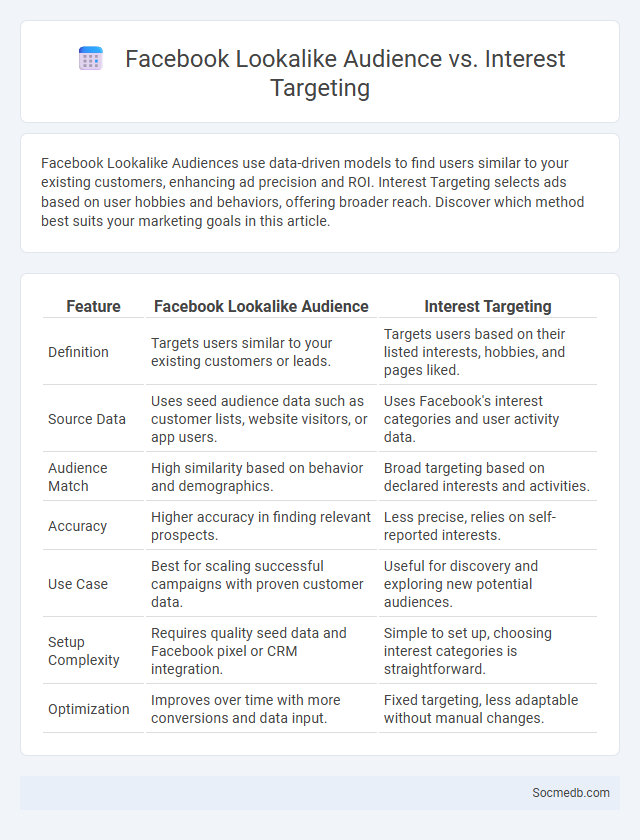
Photo illustration: Facebook Lookalike Audience vs Interest Targeting
Facebook Lookalike Audiences use data-driven models to find users similar to your existing customers, enhancing ad precision and ROI. Interest Targeting selects ads based on user hobbies and behaviors, offering broader reach. Discover which method best suits your marketing goals in this article.
Table of Comparison
| Feature | Facebook Lookalike Audience | Interest Targeting |
|---|---|---|
| Definition | Targets users similar to your existing customers or leads. | Targets users based on their listed interests, hobbies, and pages liked. |
| Source Data | Uses seed audience data such as customer lists, website visitors, or app users. | Uses Facebook's interest categories and user activity data. |
| Audience Match | High similarity based on behavior and demographics. | Broad targeting based on declared interests and activities. |
| Accuracy | Higher accuracy in finding relevant prospects. | Less precise, relies on self-reported interests. |
| Use Case | Best for scaling successful campaigns with proven customer data. | Useful for discovery and exploring new potential audiences. |
| Setup Complexity | Requires quality seed data and Facebook pixel or CRM integration. | Simple to set up, choosing interest categories is straightforward. |
| Optimization | Improves over time with more conversions and data input. | Fixed targeting, less adaptable without manual changes. |
Introduction to Facebook Advertising Targeting Options
Facebook advertising targeting options empower marketers to reach hyper-specific audiences based on demographics, interests, behaviors, and location. Advanced tools like Custom Audiences allow businesses to retarget existing customers, while Lookalike Audiences help discover new potential clients with similar profiles. Utilizing these targeting capabilities maximizes ad relevance, boosts engagement, and improves return on ad spend (ROAS).
What is a Facebook Lookalike Audience?
A Facebook Lookalike Audience is a powerful advertising tool that enables marketers to target new potential customers who share similar characteristics and behaviors with an existing group of loyal users. By analyzing data such as demographics, interests, and online activity from a source audience, Facebook's algorithm creates a highly refined audience segment to improve ad relevance and conversion rates. This audience optimization technique enhances campaign performance by expanding reach while maintaining precise targeting based on data-driven insights.
Understanding Interest Targeting on Facebook
Interest targeting on Facebook allows you to reach specific audiences based on their hobbies, behaviors, and preferences, enhancing campaign relevance and engagement. By analyzing user activity such as likes, shares, and page visits, Facebook categorizes interests that help you tailor advertisements to potential customers effectively. Optimizing your targeting strategy improves ad performance and ensures your message connects with the most relevant users.
How Lookalike Audiences Work
Lookalike Audiences use advanced algorithms to analyze your existing customer data and identify new potential customers who share similar behaviors, interests, and demographics. By leveraging this technology, you can efficiently expand your reach and improve ad targeting precision, driving higher engagement and conversion rates. Social media platforms like Facebook and Instagram continuously refine these models to deliver increasingly relevant audiences tailored to your marketing goals.
How Interest Targeting Functions
Interest targeting on social media platforms leverages user data such as browsing behavior, likes, follows, and engagement patterns to deliver highly relevant advertisements. Algorithms analyze this data to categorize users into specific interest groups, enabling advertisers to tailor content that aligns with users' preferences and increase conversion rates. By continuously updating these profiles with real-time interactions, interest targeting ensures ads remain personalized and effective in reaching niche audiences.
Key Differences: Lookalike Audience vs Interest Targeting
Lookalike Audience targets new users who share similar behaviors and characteristics with your existing customers, enhancing precision in expanding reach. Interest Targeting focuses on users based on their declared preferences, demographics, and activities, offering broader but less personalized audience segmentation. Marketers leverage Lookalike Audiences for optimized conversion rates, while Interest Targeting suits brand awareness and discovery campaigns.
Pros and Cons of Facebook Lookalike Audiences
Facebook Lookalike Audiences enable advertisers to reach new users who closely resemble their existing customers, increasing campaign relevance and improving conversion rates. However, reliance on Lookalike Audiences may limit diversity in targeting, potentially causing ad fatigue and reduced audience reach over time. Effective use requires balancing audience similarity with broadening strategies to optimize ad performance and avoid diminishing returns.
Pros and Cons of Interest Targeting
Interest targeting on social media enhances ad relevance by connecting Your content with users based on their hobbies, preferences, and behaviors, increasing engagement and conversion rates. However, it risks excluding broader audiences, potentially limiting reach and causing oversaturation among targeted groups. Balancing precise audience segmentation with diverse content exposure is essential for optimizing campaign effectiveness.
When to Use Lookalike Audience vs Interest Targeting
Using Lookalike Audiences in social media campaigns is ideal when you want to reach new users who resemble your existing customers, leveraging data patterns for higher conversion rates. Interest Targeting excels at attracting users based on specific hobbies, behaviors, or preferences, allowing you to finely tune your message to niche segments. You benefit most by choosing Lookalike Audiences for scaling efforts and Interest Targeting when exploring new markets or testing different creative strategies.
Best Practices for Facebook Audience Targeting
Effective Facebook audience targeting requires leveraging detailed demographic, interest, and behavioral data to reach your most relevant users. Utilize Custom Audiences based on your customer lists and website traffic alongside Lookalike Audiences to expand reach with high-converting potential customers. You can optimize ad performance by continuously testing and refining your targeting parameters, ensuring your content resonates with your ideal audience.
 socmedb.com
socmedb.com